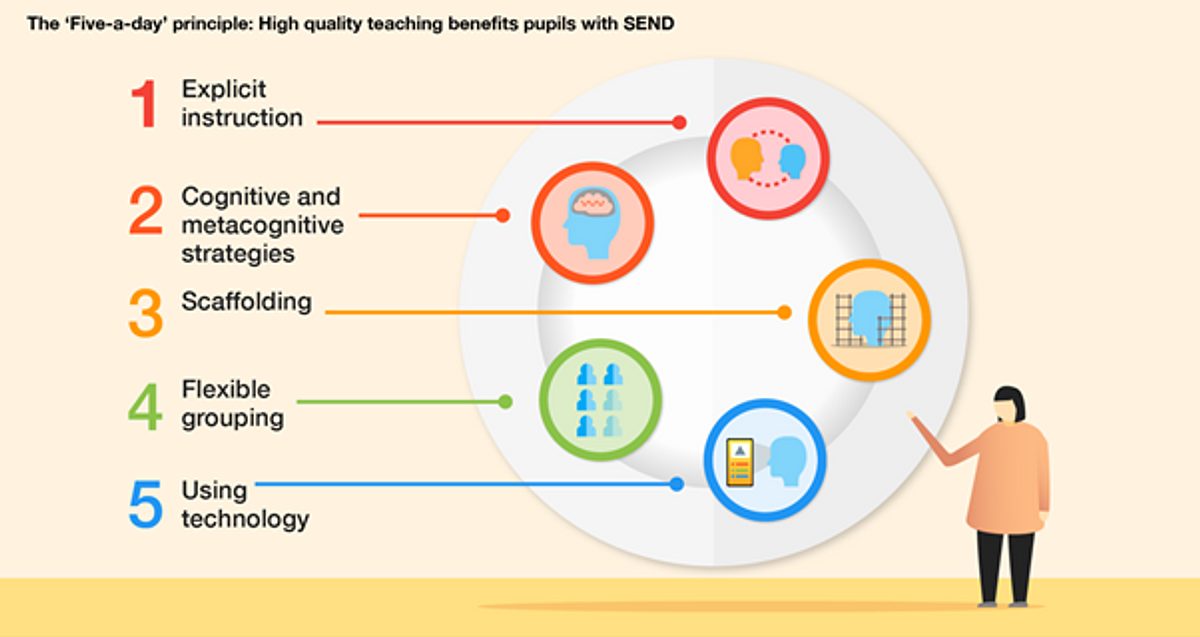The most recent advice from EEF on how to use teaching assistants
- April 4, 2025
- 0
Contents
- 1
- 2 Introduction
- 3 First, distribute TAs in such a way that all students have access to high-quality instruction
- 4 Recommendation 2 – Deploy TAs to scaffold learning and to develop pupils’ independence
- 5 Recommendation 3 – Deploy TAs to deliver well chosen, evidence based, structured interventions where appropriate
- 6 Recommendation 4 – Prepare and train staff around effective TA deployment
- 7 Recommendation 5 – Engage all staff in the process of implementing effective
Introduction
The use of teaching and learning support assistants is a valuable and highly effective method for assisting students in the classroom and through interventions. To positively impact a pupil’s progress, deploying teaching assistants must be part of a whole school strategic plan. Teaching assistants should not take the place of the teacher; rather, they should enhance and complement the teacher’s work. Teachers must maintain responsibility for their students. The role of the teaching assistant has also changed and developed in recent years. They now offer a variety of interventions in addition to assisting students in their classes. These can range from interventions to support learning (reading, numeracy, phonics, etc) to those that support social, emotional and mental health (emotional literacy support, zones of emotional regulation, education-based school avoidance, speech-language and communication, etc). For this collaborative work to be successful, all staff must be trained to a high standard.
We’ll look at the Education Endowment Foundation’s new advice on how to use teaching assistants in this blog. (Released 26/03/2025)
First, distribute TAs in such a way that all students have access to high-quality instruction
Teaching assistants should not have sole responsibility for the pupils they are working with. In-line with the SEND Code of Practice, teachers should retain responsibility for all their pupils and, according to the EEF, ‘pupils who struggle most should spend at least as much time with the teacher as other pupils, if not more.’
The primary means by which students will achieve and progress should be through high-quality first teaching. The EEF recommends that ‘schools should move away from assigning TAs to specific pupils for long periods.’ Instead, schools should ensure a collaborative approach from the teacher and teaching assistant, where pupils receive high-quality teaching and additional support, which is regularly monitored. We must avoid the teaching assistant spending time in the lesson ‘learning alongside the pupil’. Leaders need to consider how teachers and teaching assistants can spend time together before learning takes place. Other ideas recommended by the EEF include:
The teaching assistant in charge of peer reading fluency practice or other classroom activities where students learn from one another. The teaching assistant pre-teaching concepts, vocabulary, or skills before these are taught in the classroom in order to prepare pupils for learning.
The teacher divides the students in the classroom into two groups so that the TA can supervise one group while the teacher works on a learning task for the other group.
Recommendation 2 – Deploy TAs to scaffold learning and to develop pupils’ independence
We have all heard of and may have used the term “Velcro TA,” in which the teaching assistant stays with the same student but focuses on completing tasks rather than assisting the student in developing the skills necessary to comprehend, remember, and apply the material. Through high-quality CPD, teaching assistants can develop the required scaffolding skills to help pupils. The EEF describes scaffolding as ‘giving pupils the skills and tools to help themselves in situations when they do not know what to do. Through scaffolding, pupils can be supported to engage in learning in an increasingly independent manner, allowing them to better access high-quality teaching.’ As a pupil becomes increasingly independent, a cognitive strategy can be removed. Scaffolding will be personalised to the pupil, but it is important that the teacher provides the pupil with the ‘right level of challenge.’ Correcting, modeling, providing clues, prompting, and self-scaffolding are all forms of scaffolding. Correcting requires the most input from the teaching assistant and self-scaffolding is the highest level of independence.
Recommendation 3 – Deploy TAs to deliver well chosen, evidence based, structured interventions where appropriate
The new guidance from the EEF states, ‘The evidence shows that TAs can support pupils effectively through structured interventions. However, in order to guarantee positive outcomes for students, these need to be carefully considered, monitored, and connected to the classroom. Leaders must make sure that structured interventions based on evidence are used to help students progress. Again, leaders need to be sure that an intervention outside of the classroom will have the desired effect and that it will be used to complement rather than replace high-quality classroom instruction. Interventions need to be ‘targeted and relevant.’ Once an intervention has been selected, planned and delivered leaders need to make sure they are monitored for impact. The EEF suggests that monitoring can have a two-fold approach;
To establish what works in your school, monitor progress toward learning objectives. Keep an eye on how the intervention is carried out.
Recommendation 4 – Prepare and train staff around effective TA deployment
To help implement the first three recommendations it is vital that all staff are given the necessary training and skills to work together in a complementary manner. The EEF recommends ‘all school staff should be clear about the purpose of the TA role and what it involves. This is essential if teachers and TAs are to be able to work together in complementary ways, as detailed in recommendations one, two, and three.’ There must be a consistent approach about how teaching assistants can effectively support pupils. The EEF offers suggestions regarding CPD, such as: Training teachers in curriculum adaptation, how to use different strategies or interventions, and developing their understanding of pupil needs.
Teachers receiving the right professional development to feel confident and competent in working alongside TAs.
Empowering teachers to understand that effective teaching for pupils with SEND is effective teaching for all, and that such teaching is firmly based on strategies that will either already be in the repertoire of every mainstream schoolteacher or which can be relatively easily added to it.
If a specific strategy, such as scaffolding, is being used, TAs should be trained to fully understand the principles of the approach and the techniques required to apply it.
When leaders provide high-quality, personalised CPD for their teacher assistants, it shows them that they are valued and an important part of the school community.
Recommendation 5 – Engage all staff in the process of implementing effective
TA deployment
According to the EEF, “evidence suggests that if leaders take steps to facilitate their implementation, the likelihood of effective TA deployment practices being embedded is increased.” The EEF recommends:
‘Embedding a wider school culture focused on high quality teaching and inclusion.’
‘Engaging the school community in effective TA deployment’
The teaching assistant’s role and responsibilities need to be clearly articulated and carefully planned by leaders. There should be clear expectations, which are communicated to everyone and, as the EEF explains, protect the teaching assistant from role creep (the gradual expansion of their roles and responsibilities).
Lastly, a school’s teaching assistants should have a strong performance management structure as part of a clear line management structure. Helping Your Staff Support Pupils with SEND
Here at Juniper Education, we can support your leaders and teachers through a variety of courses and packages, which, in turn, will support pupils with SEND in a mainstream school.





















